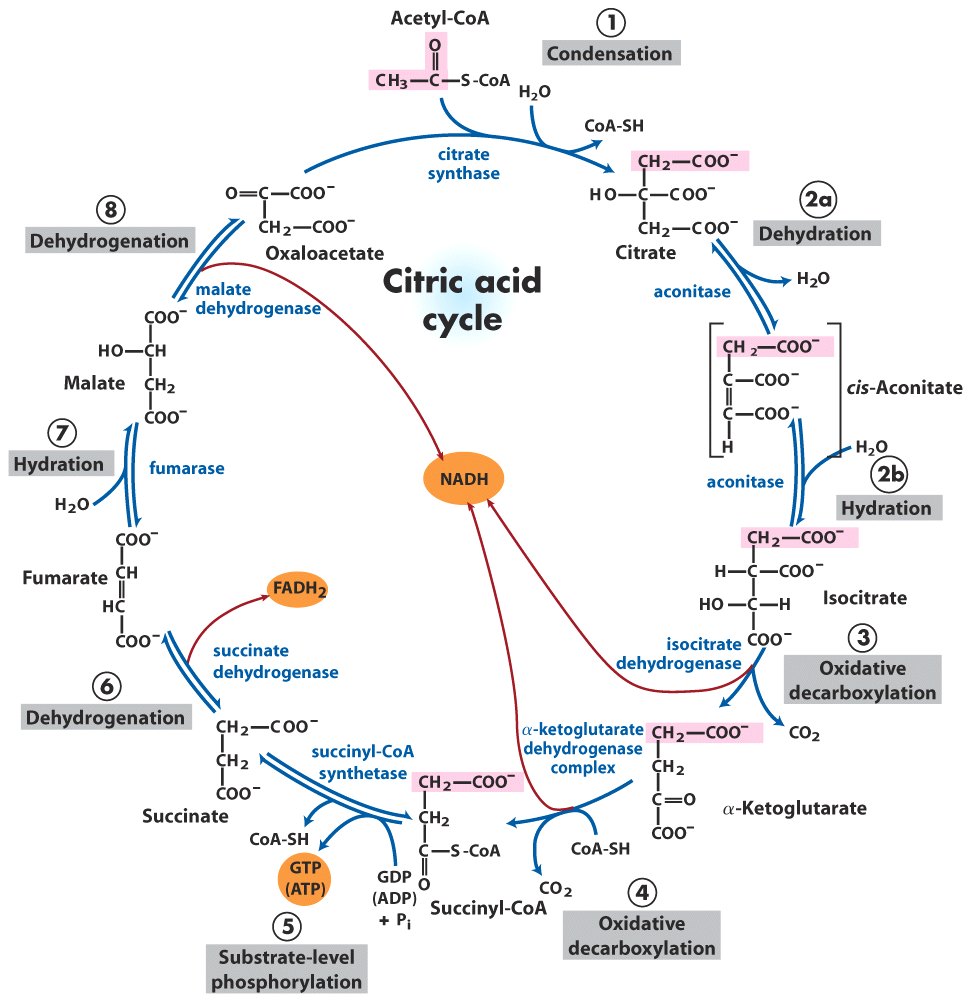Mechanisms of Inheritance
1. Find out what these folks did: Friedrich Mieschner, Edouard von Benden, August Weismann, Matthais Schleiden, Theodor Schwann, Victor Virchow.
2. You all know how osmosis works. Find out what 'aquaporins' are, and what type of biomolecule they are (lipid, sugar, protein, etc.).
3. Energy is harvested in eukaryotes by aerobic respiration: glycolysis, the gateway step, the krebs cycle, and oxidative phosphorylation (eletron transport chain - "ETC"). Look at the diagrams, below, of the Krebs Cycle and Electron transport chain. What type of molecules are the catalysts in the Krebs cycle (ending in "-ase")? What type of molecules are the colored structures in the ETC? (Each differently shaded element is a single polypeptide... they are joined together to make the functional quaternary structure).


4. So, these molecules are pretty important to what a cell does. How are they made? Where are the 'recipes' for these molecules, through what two chemical processes are these recipes "read" and these molecules built? This is known as "the central dogma" of biology.
5. Draw the unreplicated chromosomes in a cell that is 2n = 6. Put genes on the chromosomes such that homologous chromosomes are evident.
6. All cells in an organism have the same genes; each of your cells has the same 46 chromosomes (for the most part). How is it that these cells do such differnt things as muscle, neurons, secretory cells in the lining of the stomach, or photoreceptive cones and rods in the retina of your eye?
7. Describe what happens in each stage of Interphase. In cancerous cells, the cell cycle is disrupted and the G1 is typically too short. Why does this lead to further mutations?
8. Draw the chromosomes of a 2n = 4 cell proceeding through the stages of mitosis.
9. Draw the chromosomes of a 2n = 4 cell proceeding through both cycles of meiosis.
10. How does oogenesis and spermatogenesis differ in a anisogamous species?
11. Show how the movement of chromosomes in meiosis I explains Mendel's principle of segregation.... and JUST segregation!
12. Now, show how the movement of chromosomes in meiosis I explains independent assortment. Two alternative alignments must be drawn.
13. As a consequence of independent assortment alone--without considering mutation and the production of new genes--how many different combinations of chromosomes can be made in gametes by a fruit fly (2n = 8).? And for a chicken (2n = 78)?.
14. List four scales at which changes to the genome can occur.
15. Why are changes at a large scale likely to be more problematic than changes at a small scale? With respect to the human genome, what evidence exists that supports this contention?
16. Give two reasons why there are few triploid species.
17. Polyploidy is a common mechanism of producing new species in plants. Describe how this can occur WITHIN one species (autopolyploidy) and as a consequence of hybridization BETWEEN two species.
18. Why do trisomies and monosomies have such negative effects? Support your argument with the 'exception that proves the rule' - Turner's Syndrome.
19. How does gene duplication occur? How can transposons and other highly repetitive sequences influence gene duplication?
20. Explain Ohno's hypothesis describing the evolutionary importance of duplication as a source of new evolutionary novelty.
21. What spatial and genetic relationship should we expect to see among genes if they have been produced by duplications? Do these patterns exist?
22. What happens in an inversion, and how can they be evolutionarily important to the maintenance of advantageous genetic variability?
23. Why is there a difference in the heritability of trisomy and translocation Down's syndrome?
24. What is the working hypothesis for why humans have 2n=46 while other apes have 2n=48? What evidence supports this hypothesis?